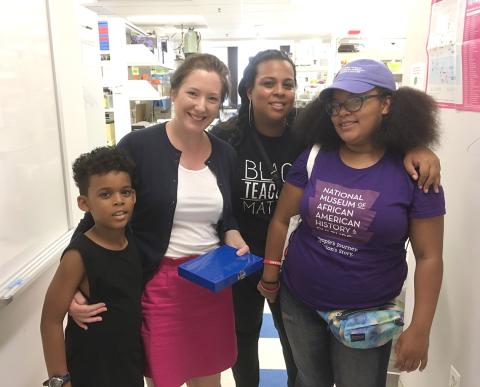NIH Employees Mentor Hopeful Scientist

Summer enrichment creates the potential for students to improve their academic performance. According to the Administration for Children and Families, children lose knowledge over the summer months when they don’t apply what they have learned during the school year.
As an elementary school math teacher, Sindia Vasquez of East Harlem knows all too well how the absence of effective summer learning opportunities can lead to gaps in achievement. Her 8-year-old son, Jesse Lucy, is interested in cancer research.
Jesse’s charter school, Success Academy, serves children who reside in communities with poverty rates above 70 percent. Last year, the school was in the top 10 percent of schools in the state of New York for academic performance in English, math and science.
Jesse, a straight-A student with plenty of personality, wants to become a scientist and has a theory about curing cancer. “I want to help a lot of people who are suffering,” he says.
So Vasquez contacted Lisa Evans, a scientific workforce diversity officer in the Office of Extramural Programs at NIH. With the help of Dr. DeLoris Hunter of the National Institute on Minority Health and Health Disparities, Evans approached Tara Mowery, chief of visitor operations at the National Library of Medicine. Mowery quickly got to work, setting up an unforgettable day for Jesse and his family.
Jesse, his mother and his 13-year-old sister Brianna—who expressed a desire to become an attorney—embarked on a 4-hour tour where they met some employees with close ties to their home in Harlem.
Troy Wise, a desktop security analyst at NLM and a native of Harlem, interacted with Jesse and offered him plenty of encouragement on his journey. When Wise asked Jesse what he loved about science, the reply was, “Everything.”
Jesse also met with Dr. Terry Yoo, a computer scientist at NLM, who provided Jesse a hands-on demonstration of 3-D models and explained how NIH is helping people with cancer. Next, Jesse was guided to the virtual/augmented reality desk, where he donned a virtual reality headset and experienced an interactive display of the human heart. Jesse, who likes to be called “Professor Lucy,” found this very “cool.”
Jesse visited biologist Kevin Bishop, also from Harlem, in the zebrafish core facility of the National Human Genome Research Institute. There he saw firsthand how researchers perform experiments, illuminate disease mechanisms and learn how much humans and fish are alike.
Before leaving, Jesse and his family had lunch with Herman Chenwi, a post-baccalaureate fellow in the Division of Intramural Research of the National Institute of Child Health and Human Development, to discuss—what else?—science. The group then met with Stadtman investigator Dr. Brid Ryan of the National Cancer Institute, who showed Jesse what cancer cells look like under a microscope and discussed interventions and treatments.
After the tour, the family collected plenty of goodies and NIH swag. Jesse is sure to benefit from what he learned this summer at NIH. He will deliver a presentation about his visit when he returns to school in the fall, while Brianna, at Bishop’s urging, now considers science a potential career option.
NIMHD’s Hunter thinks Jesse will be an inspiration to many young students of color who want to pursue a career in biomedical science.
